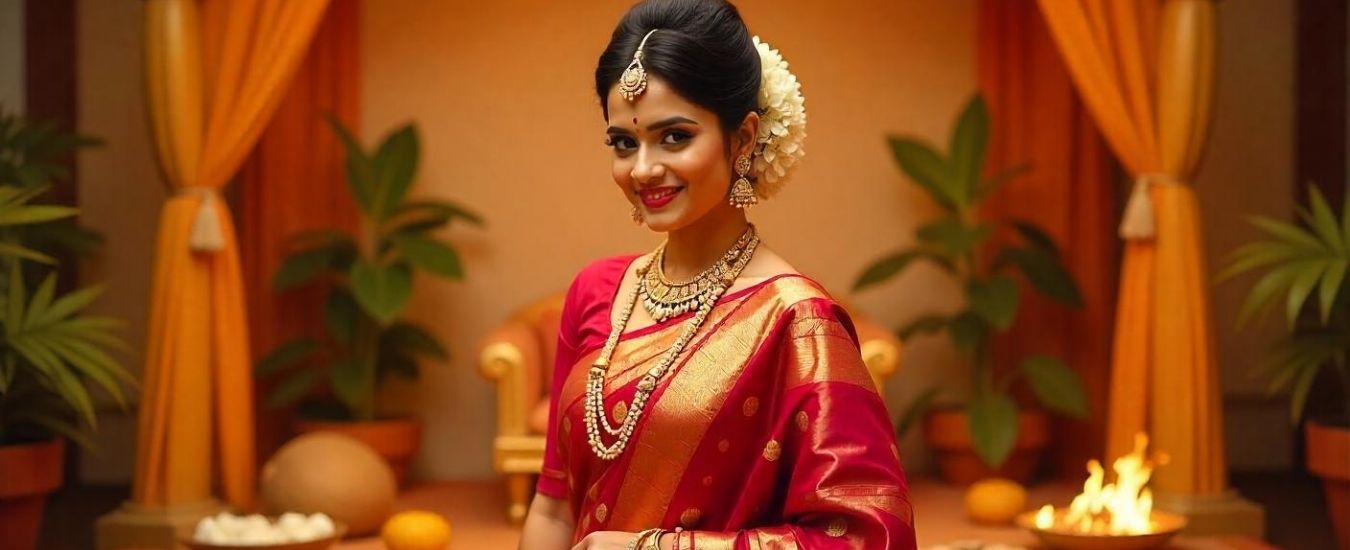South Indian weddings are a vibrant celebration of South Indian culture, blending ancestral customs with deep ritualistic significance. For the bride, the journey is a profound mix of sacred ceremonies, emotional moments, and matrimonial bonds. This guide explores the wedding preparations and rituals—what happens, when, and how—highlighting regional variations and their spiritual essence.
South Indian bridal rituals are a spiritual tapestry of sacred ceremonies and ancestral customs, weaving love, community, and ritualistic significance. From Vratham to Arundhati Nakshatram, these traditions honour the bride’s journey, making her smile a testament to South Indian culture.
Grab a cup of filter coffee and dive into this rich tradition!
Pre-Wedding Rituals
Nischayathartham (Engagement Ceremony)
The journey begins with Nischayathartham, a formal engagement where families unite to forge a matrimonial bond. Beyond exchanging rings, it involves Jathakam (horoscope) matching to ensure harmony and prosperity, often accompanied by Vedic mantras for blessings.
Lagna Patrika & Pandakkal
The Lagna Patrika, an official wedding announcement, is read aloud, confirming the Muhurtham (auspicious time). The Pandakkal, a bamboo post-erection, marks the start of festivities, often with Nadaswaram music setting the tone.
Vratham and Sumangali Prarthanai
In many traditions, the bride and groom undertake Vratham, a fasting ritual for spiritual purity. The Sumangali Prarthanai honours married women, invoking blessings from Lakshmi-Narayana for a prosperous marriage.
Pre-Wedding Beauty and Auspicious Preparations
Haldi and Pallikai Thellichal
Some communities apply turmeric during Haldi, while others perform Pallikai Thellichal, where seeds are soaked in clay pots for fertility and abundance. In Brahmin weddings, the playful Kashi Yatra sees the groom feign renunciation, only to be persuaded by the bride’s father.
Applying Mehendi
Though not traditional, Mehendi nights are now popular, with brides adorning intricate henna designs, often paired with Thamboolam (betel leaf exchanges).
Gauri Puja and Tulasi Puja
The bride performs Gauri Puja to seek blessings from Goddess Parvati, embodying devotion. Some families also conduct Tulasi Puja, venerating the sacred basil for purity, with women chanting Vedic mantras.
Mangalasnanam (Sacred Bath)
The bride’s Mangalasnanam involves a ritual bath with turmeric, scented oils, and herbal water, symbolizing spiritual cleansing, often accompanied by Homam (fire rituals).
Wedding Day Rituals for the South Indian Bride
Kanjeevaram Saree and Bridal Adornments
The bride dazzles in a Kanjeevaram saree or Kasavu saree (for Malayali brides), adorned with temple jewellery, jasmine flowers, and Sindooram on her forehead, reflecting marital vows.
Arrival at the Mandapam
Greeted with aarti and rice sprinkles, the bride enters the mandapam, where Nadaswaram and drums create an electrifying atmosphere.
Kanyadaanam – Giving Away the Bride
In this emotional ritual, the bride’s father entrusts her to the groom during Paanigrahanam, symbolizing trust and love, blessed by Shiva-Parvati.
Mangalya Dharanam – The Sacred Thread
The groom ties the Thali (Mangalsutra) around the bride’s neck during the Muhurtham, with Vedic mantras and drumbeats, sealing the marriage.
Saptapadi and Arundhati Nakshatram
The couple takes seven steps (Saptapadi), each a vow for health, wealth, and happiness. Afterwards, they gaze at the Arundhati Nakshatram (star), symbolizing loyalty.
Region-Specific Bridal Rituals
Tamil Bride’s Rituals
Tamil brides wear a Koorai saree post-Thali, enjoy the Oonjal swing ceremony, and engage in the playful Nalangu with Thamboolam exchanges.
Telugu Bride’s Rituals
In Janavasam, the groom arrives in a procession. The Jeelakarra Bellam ritual unites the couple, followed by the bride wearing a Madhuparkam saree.
Kannada Bride’s Rituals
The Dhare Herdu involves pouring sanctified water, while Kankana Dharane ties sacred threads, often with Homam rituals.
Malayali Bride’s Rituals
The Pudava Kodukkal gifts a Mundum Neryathum saree, and Nischayam formalizes the agreement, rooted in South Indian culture.
Tulu and Coorgi Weddings
In Tulu weddings, rituals like Dharma Aras’ blessing add uniqueness, while Coorgi weddings feature Kodava attire and ancestral blessings.
Post-Wedding Rituals
Griha Pravesham
The bride enters her new home with aarti and rice-kicking, symbolizing prosperity, often with Lakshmi-Narayana puja.
Reception and Welcoming Ceremonies
A grand reception follows, where the bride, adorned with Metti and Kumkum, meets extended family, celebrating the matrimonial bond.
Symbols of a Married South Indian Woman
The Thali, Metti, Kumkum, and Sindooram are sacred symbols. The bride’s hairstyle and saree drapes, like Mundum Neryathum, reflect her new role.
FAQs
What is the significance of the Thali?
The Thali symbolizes marital commitment, tied during Mangalya Dharanam.
Do all South Indian brides wear the same attire?
No, Tamil brides wear Koorai sarees, Malayali brides wear Kasavu sarees, and so on.
How long do these rituals last?
Typically, 2–3 days, including wedding preparations.
Is Mehendi traditional?
No, but modern brides adopt it with Thamboolam for festivity.
Are these rituals followed in urban weddings?
Yes, often blends ancestral customs with modern elements.
